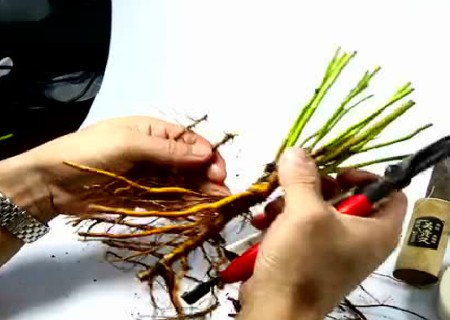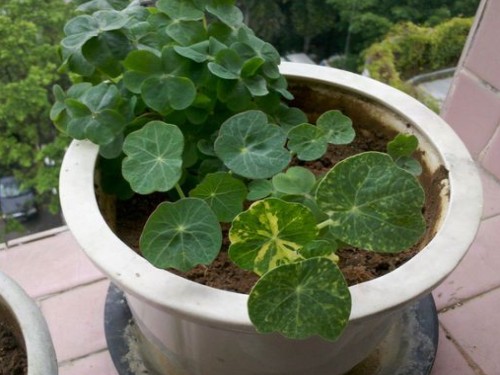Sowing diary and climbing frame pictures of Nelumbo nucifera
Clematis is an annual or perennial climbing succulent herb. Stem slender, fleshy hollow, smooth and glabrous. Leaves long-stalked, round, peltate, shaped like lotus leaves. The flowers are yellow or orange, with a sweet taste and can blossom all the year round under suitable climate conditions. The fragrance is sweet, the color is bright, and it is deeply loved by people.

For those flower lovers who plant Clematis paniculata for the first time, what they want to know most is how to sow seeds, when to plant them in pots, and when to apply fertilizer to hit the top. Let's briefly talk about the breeding process from sowing to harvest.
[sowing]
Golden lotus can be sowed in spring or autumn. Because of the long growth cycle, the performance of autumn sowing is much better than that of spring sowing. The plant type is compact, the flower quantity is large and concentrated, it is suitable for hanging, and the seed is many and full. The spring-sown dry lotus has thin branches and long internodes, which is suitable for climbing and has few and small seeds.
Sprouting can be carried out before sowing, of course, if you are as lazy as I am in the advanced stage of cancer, then sow directly!
1. Sprouting methods:
①, first soak the seeds in clear water for a day, and wait for the wrinkled skin on the surface of the seeds to stretch without wrinkling.
②, use a disposable plastic lunch box, of course, other boxes are also possible, spread 2 layers of paper towels on the bottom of the box, and spray. Note: do not use scented paper towels. Put the seeds on the paper towels and cover them with a layer of paper towels. Then close the lid and start sprouting. When the temperature is above 20 degrees, it can be exposed in about 3 days.
2. Sowing:
①, after the seeds stick out their white legs, they can be sown. First, put the peat, perlite and vermiculite in the seedling basin at the proportion of 1:1:1.
②, make a hole in the middle of the soil, the hole should be big enough to put into the seed. Gently put the exposed seeds into the hole and be careful not to break the white buds. Then gently cover the dirt. Keep the soil moist and the seeds can break out after 3-5 days.
[raising seedlings]
After breaking the soil, the seedlings of ① and Clematis should be moved to bright light as soon as possible and gradually moved to the sun for maintenance so as not to grow too much.
②, when the lotus grows 5-6 leaves, it is necessary to pick the heart to promote the germination of lateral branches, which can blossom more in the future. For the first time, keep 4 leaves.
③ and Nelumbo nucifera need not be fertilized at the seedling stage. After the first coring, the root system grows all over the seedling basin and can be planted in the pot.
[colonization]
The soil for the colonization of Clematis paniculata can use peat + perlite + vermiculite at the ratio of 1:1:1 and then add 10% granular chicken manure and 10% earthworm manure as base fertilizer.
[picking hearts and topdressing]
After planting, the lateral branches were enucleated for the second time when they grew 4 leaves. Need to pick the heart many times, the plant can achieve full effect.
In order to make Nelumbo nucifera blossom early, root irrigation and foliar spraying were carried out alternately with potassium dihydrogen phosphate dilution every 7 days during the growing period.
[pollination]
After flowering, if there is no need to leave seeds, the residual flowers should be cut off in time to avoid consuming too much nutrients to facilitate the formation of new flower buds.
The dry lotus raised outdoors does not need artificial pollination, and the wind and insects will accomplish this task. But if it is kept indoors, artificial pollination is needed before seeds can be produced.
Artificial pollination is suitable for the morning on a sunny day. When the stamen pops up and the pistil is "human", the pollen is coated on the pistil, the same flower can be pollinated, and the pollen will wither quickly after pollination, and when the flower stalk is bent in a spiral shape, it indicates that the pollination is successful.
[harvest and storage]
Mature seeds will fall on their own. After drying in the sun, the seeds can be preserved in a cool place.
Dry golden lotus potted in spring and autumn should be placed in a sunny place, summer should be properly shaded, put in a ventilated and cool environment, and timely watering. In the middle of October, the north moved indoors or pinched some branches and put them in the sunny place. if there is enough sunshine, they can continue to take root, grow leaves and blossom.
Clematis is an annual or perennial climbing succulent herb. The stem cannot be upright, and when it grows to 50 cm high, it needs to be framed. Can be built into a variety of different styles. Here are some pictures of the potted climbing frame of Golden Lotus:
Hemispherical
Hemispherical
Spindle shape
Triangular shape
Cylindrical shape
Plane trapezoid
Time: 2019-06-10 Click:
- Prev

Root grafting technique of Rose-- Root grafting method of bare Root seedlings
Speaking of root grafting, we need to talk about grafting first. Why? Because root grafting belongs to the two ways of grafting, branch grafting and bud grafting. Grafting is one of the methods of artificial vegetative propagation of plants. That is, the branch or bud of one plant is grafted onto the stem or root of another plant.
- Next

Breeding methods of Clematis paniculata
Nelumbo nucifera is a perennial trailing herbaceous flower of the genus Clematis of the family Nelumbo nucifera. Stem fleshy hollow, grayish green, simple leaves alternate, long petiolate, peltate-rounded entire undulate. The flower ends on a symmetrical slender pedicel drawn from leaf axils, with yellow, red, orange, purple, milky white and complex colors. The fruit is pale green
Related
- Fuxing push coffee new agricultural production and marketing class: lack of small-scale processing plants
- Jujube rice field leisure farm deep ploughing Yilan for five years to create a space for organic food and play
- Nongyu Farm-A trial of organic papaya for brave women with advanced technology
- Four points for attention in the prevention and control of diseases and insect pests of edible fungi
- How to add nutrient solution to Edible Fungi
- Is there any good way to control edible fungus mites?
- Open Inoculation Technology of Edible Fungi
- Is there any clever way to use fertilizer for edible fungus in winter?
- What agents are used to kill the pathogens of edible fungi in the mushroom shed?
- Rapid drying of Edible Fungi

